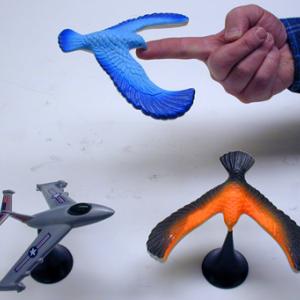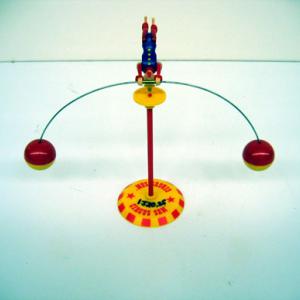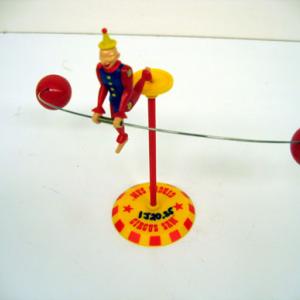College of Liberal Arts & Sciences
1J20.35 - Bird, Plane, and Circus Clown
Take the bird or the plane off the stand and balance on the end of a finger or blunt rod. These figures can also be spun about the balance point without losing equilibrium.
The clown is much like the plane and bird when the figure is standing on its head. The figure can also be put into other configurations and positions and the balls repositioned to provide equilibrium.
- James Lincoln, "Ten Annoying Experiments to do at Dinnertime", TPT, Vol. 63, #2, Feb. 2025, p. 136.
- Thomas B. Greenslade Jr., "Balancers Redux", TPT, Vol. 59, #7, Oct. 2021, p. 540.
- Connor Hazelrigg and Blane Naker, "Center of Mass Demonstration on the Fly", TPT, Vol. 53, #1, Jan. 2015, p. 50.
- Robert G. Kirkham, "Choosing the Right System for Analysis of Forces", TPT, Vol. 34, #6, Oct. 1996, p. 402.
- A. John Mallinckrodt, J. Machael Shore, and Marvin L. De Jong, "On 'Choosing the Right System for Analysis of Forces'", TPT, Vol. 34, #9, Dec. 1996, p. 534.
- Henry Levinstein, "The Physics of Toys", TPT, Vol. 20, #6, Sept. 1982, p. 358, also a Potpourri of Physics Teaching Ideas - Toys, p. 269.
- Thomas B. Greenslade, Jr., "Balancers", TPT, Vol. 19, #8, Nov. 1981, p. 554.
- Y. S. Horowitz, "A Simple Demonstration of the Concept of Center of Mass", TPT, Vol. 10, #8, Nov. 1972, p. 464.
- Brother Shamus Mahoney, "Center of Gravity Demonstration", TPT, Vol. 6, #6, Sept. 1968, p. 324.
- W. N. Mei and Dan Wilkins, "Making a Pitch for the Center of Mass and the Moment of Inertia", AJP, Vol. 65, #9, Sep. 1997, p. 903.
- Raymond C. Turner, "Toys in Physics Teaching: Balancing Man", AJP, Vol. 55, #1, Jan. 1987, p. 84.
- M- 474: "Fork and Spoon - Belt", DICK and RAE Physics Demo Notebook.
- M- 462: "Balance-a-Bee", DICK and RAE Physics Demo Notebook.
- Terrence P. Toepker, "More Center of Gravity", A Potpourri of Physics Teaching Ideas - Mechanics, p. 100.
- Ernie McFarland, "Center of Mass Revisited", A Potpourri of Physics Teaching Ideas, p. 97.
- Cy Tymoney, "Sneaky Balancer I", Sneakiest Uses for Everyday Things, p. 11.
- Cy Tymoney, "Sneaky Balancer II", Sneakiest Uses for Everyday Things, p. 14.
- Cy Tymoney, "Sneaky Balancer IV", Sneakiest Uses for Everyday Things, p. 17.
- Jodi and Roy McCullough, "Center of Gravity with a Balancing Bird", The Role of Toys in Teaching Physics, p. 4.60.
- Jodi and Roy McCullough, "Center of Gravity with a Balancing Bear", The Role of Toys in Teaching Physics, p. 4.110.
- Charles Vivian, "Balancing the Impossible", Science Experiments & Amusements For Children, p. 24.
- Martin Gardner, "Make a Magic Bird", Science Tricks, p. 32.
- Martin Gardner, "Balancing Silverware", Science Tricks, p. 31.
- Martin Gardner, "95, A Balancing Feat", Smart Science Tricks, p. 140.
- Martin Gardner, "The Precarious Forks", Entertaining Science Experiments with Everyday Objects, p. 81.
- Borislaw Bilash II, David Maiullo, "Balancing Act", A Demo a Day: A Year of Physics Demonstrations, p. 154.
- "Old-Time Magic: Balancing Forks on a Pin Head", The Boy Mechanic Makes Toys, p. 39.
- Janice VanCleave, "75, Butterfly Magic", Teaching the Fun of Physics, p. 114.
- Janice VanCleave, "76, Balancing Point", Teaching the Fun of Physics, p. 115.
- Borislaw Bilash II, “Balancing Act“, A Demo A Day – A Year of Physical Science Demonstrations, p. 210.
- Julius Sumner Miller, Q168 & A168, Millergrams II – Some More Enchanting Questions for Enquiring Minds, p. 41 & 96.
Disclaimer: These demonstrations are provided only for illustrative use by persons affiliated with The University of Iowa and only under the direction of a trained instructor or physicist. The University of Iowa is not responsible for demonstrations performed by those using their own equipment or who choose to use this reference material for their own purpose. The demonstrations included here are within the public domain and can be found in materials contained in libraries, bookstores, and through electronic sources. Performing all or any portion of any of these demonstrations, with or without revisions not depicted here entails inherent risks. These risks include, without limitation, bodily injury (and possibly death), including risks to health that may be temporary or permanent and that may exacerbate a pre-existing medical condition; and property loss or damage. Anyone performing any part of these demonstrations, even with revisions, knowingly and voluntarily assumes all risks associated with them.


